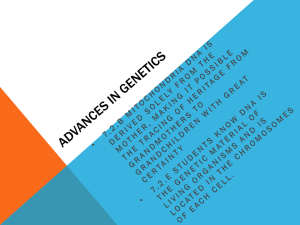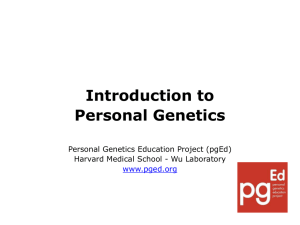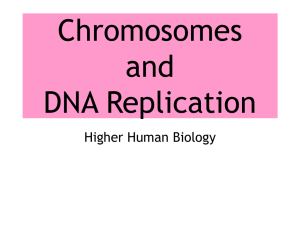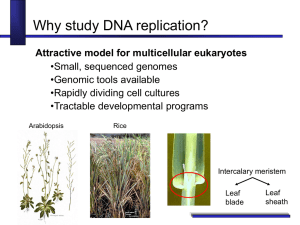Unit Planner 2015
advertisement
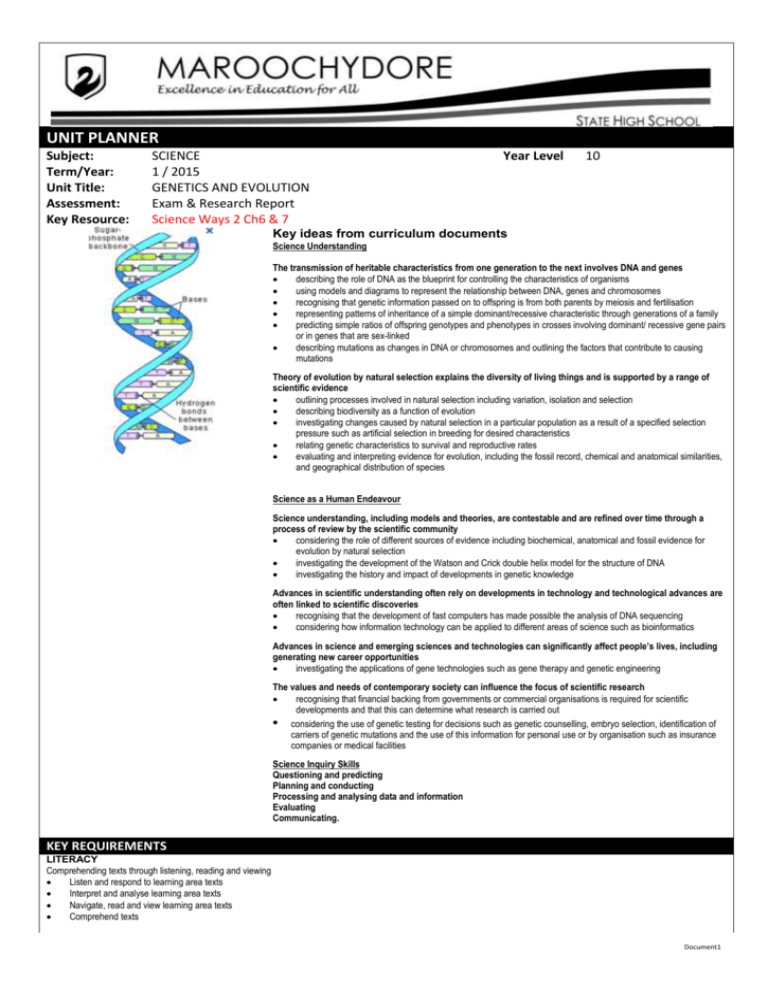
UNIT PLANNER Subject: Term/Year: Unit Title: Assessment: Key Resource: SCIENCE 1 / 2015 GENETICS AND EVOLUTION Exam & Research Report Science Ways 2 Ch6 & 7 Year Level 10 Key ideas from curriculum documents Science Understanding The transmission of heritable characteristics from one generation to the next involves DNA and genes describing the role of DNA as the blueprint for controlling the characteristics of organisms using models and diagrams to represent the relationship between DNA, genes and chromosomes recognising that genetic information passed on to offspring is from both parents by meiosis and fertilisation representing patterns of inheritance of a simple dominant/recessive characteristic through generations of a family predicting simple ratios of offspring genotypes and phenotypes in crosses involving dominant/ recessive gene pairs or in genes that are sex-linked describing mutations as changes in DNA or chromosomes and outlining the factors that contribute to causing mutations Theory of evolution by natural selection explains the diversity of living things and is supported by a range of scientific evidence outlining processes involved in natural selection including variation, isolation and selection describing biodiversity as a function of evolution investigating changes caused by natural selection in a particular population as a result of a specified selection pressure such as artificial selection in breeding for desired characteristics relating genetic characteristics to survival and reproductive rates evaluating and interpreting evidence for evolution, including the fossil record, chemical and anatomical similarities, and geographical distribution of species Science as a Human Endeavour Science understanding, including models and theories, are contestable and are refined over time through a process of review by the scientific community considering the role of different sources of evidence including biochemical, anatomical and fossil evidence for evolution by natural selection investigating the development of the Watson and Crick double helix model for the structure of DNA investigating the history and impact of developments in genetic knowledge Advances in scientific understanding often rely on developments in technology and technological advances are often linked to scientific discoveries recognising that the development of fast computers has made possible the analysis of DNA sequencing considering how information technology can be applied to different areas of science such as bioinformatics Advances in science and emerging sciences and technologies can significantly affect people’s lives, including generating new career opportunities investigating the applications of gene technologies such as gene therapy and genetic engineering The values and needs of contemporary society can influence the focus of scientific research recognising that financial backing from governments or commercial organisations is required for scientific developments and that this can determine what research is carried out • considering the use of genetic testing for decisions such as genetic counselling, embryo selection, identification of carriers of genetic mutations and the use of this information for personal use or by organisation such as insurance companies or medical facilities Science Inquiry Skills Questioning and predicting Planning and conducting Processing and analysing data and information Evaluating Communicating. KEY REQUIREMENTS LITERACY Comprehending texts through listening, reading and viewing Listen and respond to learning area texts Interpret and analyse learning area texts Navigate, read and view learning area texts Comprehend texts Document1 Composing texts through speaking, writing and creating Compose texts Compose spoken, written, visual and multimodal learning area texts Use language to interact with others Deliver presentations Word Knowledge Understand learning area vocabulary Use spelling knowledge Text knowledge Use knowledge of text cohesion Use knowledge of text structures Grammar knowledge Use knowledge of sentence structures Use knowledge of words and word groups Express opinion and point of view Visual Knowledge Understand how visual elements create meaning NUMERACY Using fractions, decimals, percentages, ratios and rates Interpret proportional reasoning Apply proportional reasoning Using measurement Estimate and measure with metric units Interpreting statistical information Interpret chance events Interpret data displays Using spatial reasoning Visualise 2D shapes and 3D objects Interpret maps and diagrams Recognising and using patterns and relationships Recognise and use patterns and relationships ICTs Applying social and ethical protocols and practices when using ICT Identify the impacts of ICT in society Investigating with ICT Define and plan information searches Select and evaluate data and information Locate, generate and access data and information Managing and operating ICT Manage digital data Select and use hardware and software CRITICAL & CREATIVE THINKING Inquiring – identifying, exploring and organising information and ideas Organise and process information Identify and clarify information and ideas Reflecting on thinking and processes Transfer knowledge into new contexts Reflect on processes Analysing, synthesising and evaluating reasoning and procedures Evaluate procedures and outcomes Draw conclusions and design a course of action Apply logic and reasoning Generating ideas, possibilities and actions Imagine possibilities and connect ideas Consider alternatives Seek solutions and put ideas into action . DIFFERENTIATION Students requiring support can… The learning experiences within this unit can be differentiated by increasing: • the frequency of exposure for some students • the intensity of teaching by adjusting the group size • the duration needed to complete tasks and assessment Students requiring extension can… For guided and/or independent practice tasks: • student groupings will offer tasks with a range of complexities to cater for individual learning needs • rotational groupings that allow for more or less scaffolding of student learning Document1 10 Science Term 1 Week 1 Lesson 1 2015 Lesson 2 • Identify and understand the structure of DNA and where it is found 2 3 Lesson 3 • Understand that all organisms have heritable characteristics. • Identify heritable characteristics? (Make a DNA model) • Define key terms about heredity. • Understand the relationship between DNA, genes, chromosomes, genotype, traits, and phenotype. • Understand the relationship between DNA, genes, and alleles, understand the difference between dominant and recessive alleles. • Investigate Gregor Mendel's experiments and key results 4 • Understand how Punnet squares can be used to determine the potential genotypes and phenotypes of offspring from a given cross. (Monohybrid crosses including co-dominance, incomplete dominance, blood groups, sex linkage and dihybrid for extension classes.) . 5 Continue Punnet squares and review • explore the use of DNA-based technologies and associated careers • understand how DNA can be extracted from plant cells. • Extract DNA from plant cells. 6 • Understand the structure and function of pedigrees. • Complete a multi-generational pedigree tracking a specific trait? • Explain how pedigrees can be used to track traits? • Extract Cheek Cell DNA 7 8 9 • Understand the role of meiosis in sexual reproduction. • Understand the different ways meiosis introduces genetic diversity. • Understand the impact of asexual and sexual reproduction on the genotype of offspring. • Understand that mutations can alter an organism's phenotype. • Examine different diseases caused by mutations • Introduction to evolution and major concepts – natural selection and change over time Evidence of evolution Catch up and Review EXAM 10 Critical Learning Lesson Literacy Focus Numeracy Focus ICT lesson Creative Thinking Practical Lesson Key Words chromosome allele gene meiosis phenotype genotype heterozygous DNA mitosis pedigrees hybrid evolution dominant purebred species Natural selection Trait Homozygous recessive Co-dominance Document1





